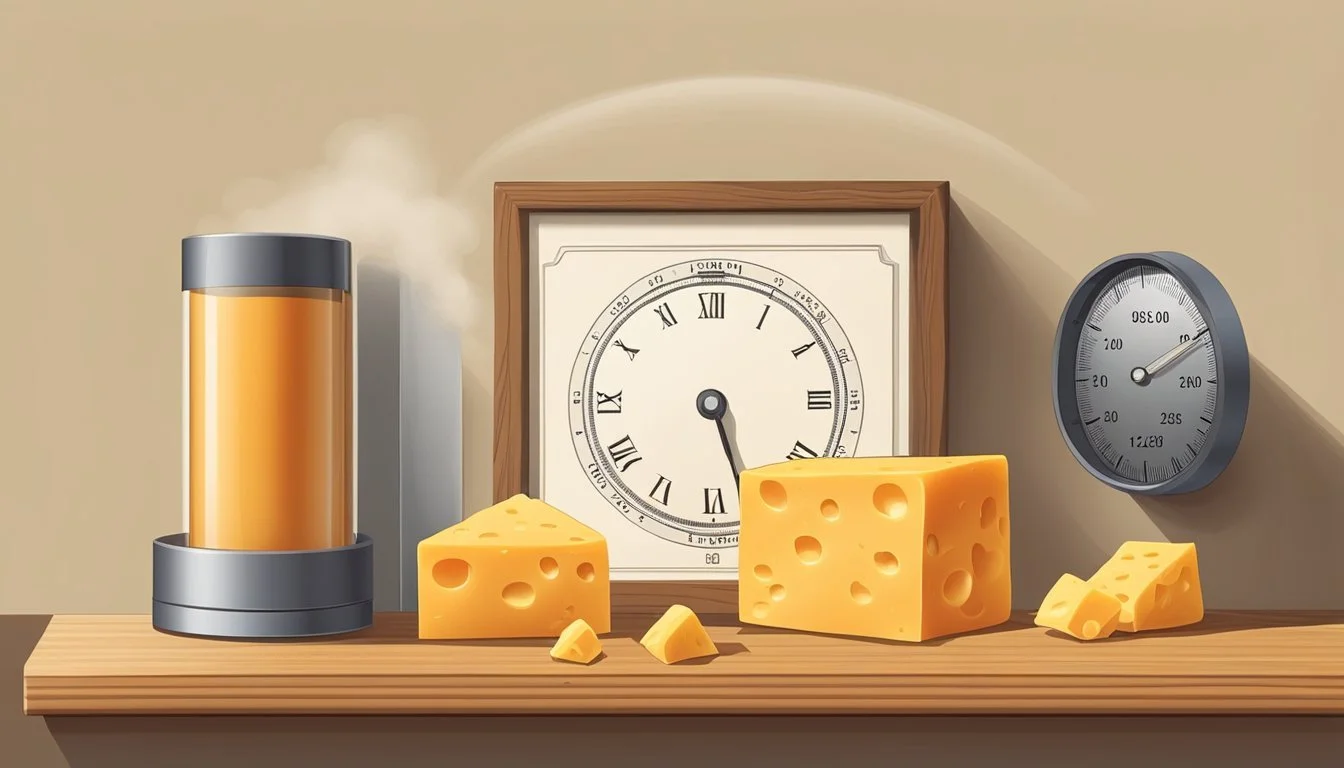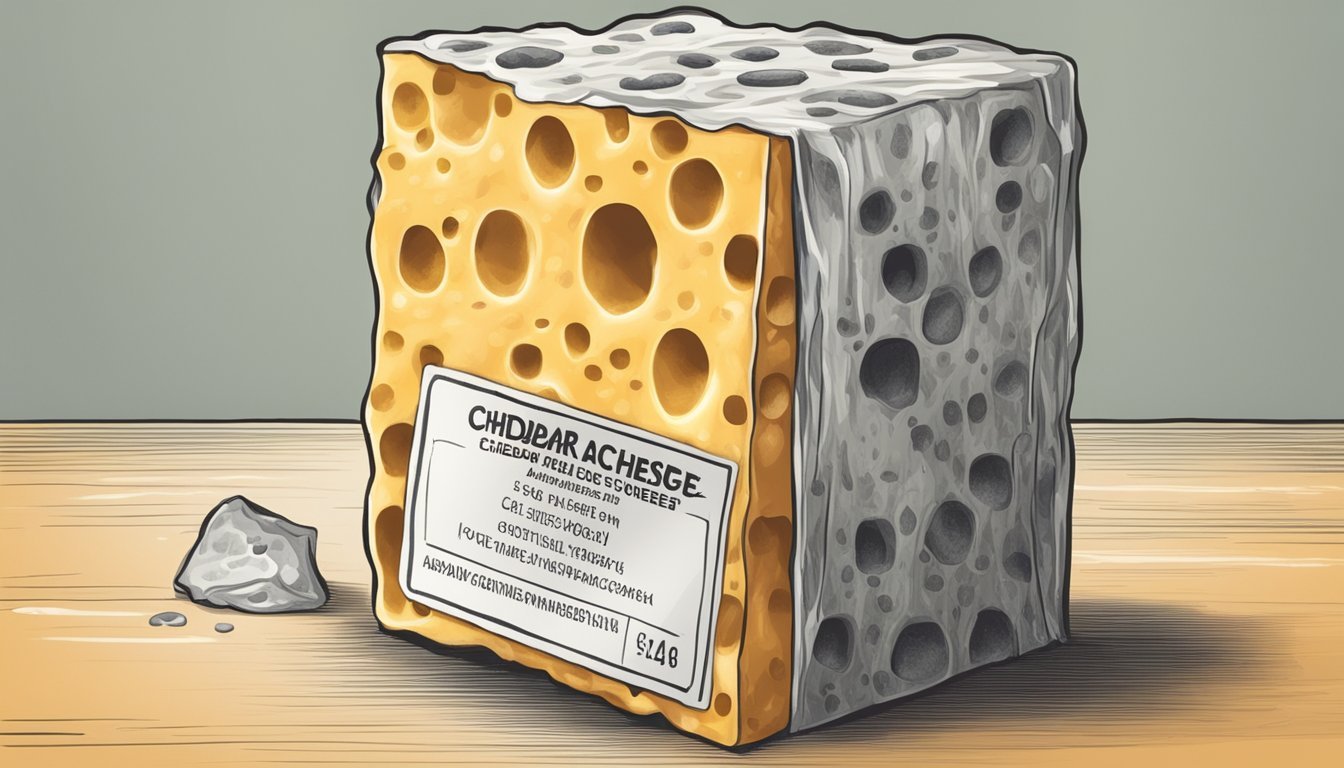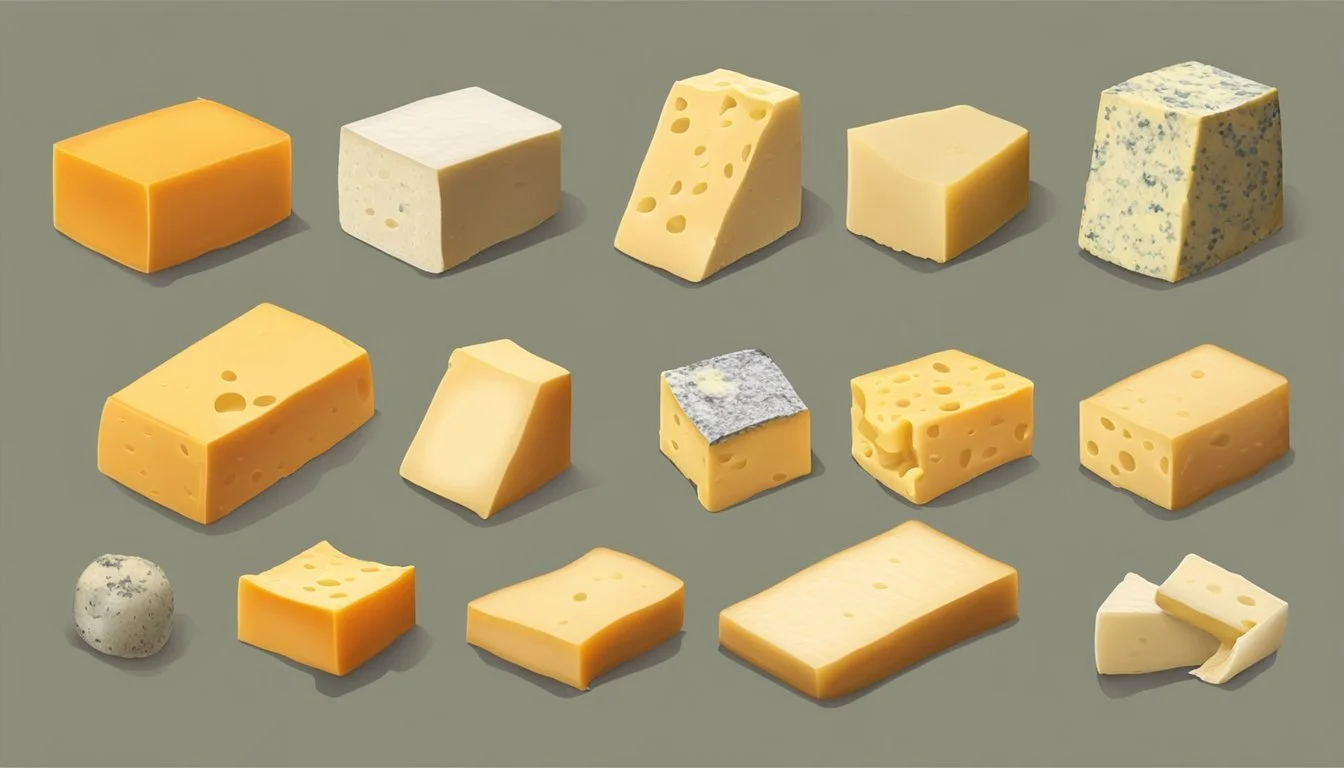Does Cheddar Cheese Go Bad?
Essential Tips for Storage and Shelf Life
Cheddar cheese, like any dairy product, has a shelf life, and it's essential to know when it goes bad to avoid foodborne illness. Cheddar cheese will usually keep for 3-4 weeks in your fridge, but after this period, it can start to show signs of spoilage. Mold stains, an off odor, and an excessively sticky or mushy texture indicate that the cheese may be past its prime.
Understanding the signs of spoilage can help ensure that your cheddar remains a delightful addition to your meals. If cheddar cheese has turned brown, gray, or green, or if it has developed a slimy texture or a strong, foul odor, it's best to discard it. These changes are clear indicators that the cheese is no longer safe to consume.
Recognizing these signs early can save you from the unpleasant experience of tasting spoiled cheese and help maintain the quality of the food you serve. Whether you’re a cheese connoisseur or just someone who enjoys cheddar occasionally, knowing these details will help you enjoy your cheddar at its best.
Understanding Cheddar Cheese
Cheddar cheese is a widely enjoyed dairy product made from cow's milk. It falls into the category of hard cheeses, known for their firmness and longer shelf life compared to soft cheeses.
Origin: This cheese type originated in the English village of Cheddar in the 12th century.
Flavor & Taste: Cheddar's flavor varies from mild to sharp, influenced by its aging process. Younger cheddar tends to be mild and creamy, while aged cheddar has a more robust, complex taste.
Texture: Fresh cheddar is smooth and firm. As it ages, it becomes more crumbly and brittle.
Aging Process:
Mild Cheddar: Aged for 2-3 months
Medium Cheddar: Aged for 4-6 months
Sharp Cheddar: Aged for 9-12 months
Extra Sharp Cheddar: Aged for over a year
Production: The process involves curdling milk with rennet, cutting the curd, draining the whey, and pressing the curds into molds. The cheese is then aged to develop its taste and texture.
Nutritional Profile: Cheddar is rich in calcium, protein, and fats. It provides essential nutrients, contributing to a balanced diet when eaten in moderation.
Usage: Popular for its versatility, cheddar is used in sandwiches, salads, baked dishes, and as a standalone snack.
Cheddar stands out not just for its taste but also for its adaptability in various culinary applications, making it a staple in many kitchens.
Signs of Spoilage in Cheddar Cheese
Knowing when cheddar cheese has gone bad is crucial for both safety and taste. Key indicators include visual changes, alterations in texture, and shifts in odor or flavor.
Visual Indicators of Spoilage
One of the first signs that cheddar cheese may be bad is visual changes. Mold growth is a primary indicator. While some cheeses are meant to have mold, such as blue cheese, any visible growth on cheddar, especially in colors like green, blue, or black, signifies spoilage.
Discoloration is another sign. If the cheese turns brown, gray, or has visible dark spots, it should not be consumed. Additionally, watch out for any unusual sliminess on the surface, as this can be a sign of bacterial growth and spoilage.
Texture and Consistency Changes
Changes in texture and consistency are clear indicators of cheddar cheese going bad. Fresh cheddar has a firm and slightly crumbly texture. If the cheese becomes excessively sticky, mushy, or slimy, it is a sign that it has spoiled.
Crystallization might occur in aged cheddar, but this is not an indicator of spoilage. Instead, focus on any significant changes from the cheese’s original state. If it feels different from when it was fresh, it is likely past its prime and should be discarded.
Odor and Taste Assessment
Odor plays a significant role in identifying spoiled cheddar cheese. Fresh cheddar has a mild, pleasant aroma. An off smell, such as a strong, unpleasant, or sour smell, is a clear signal that the cheese is no longer good.
Taste can also reveal spoilage. While cheddar is supposed to have a tangy flavor, a pungent or bitter taste indicates that it has gone bad. If the cheese tastes off in any way, it is best to err on the side of caution and dispose of it.
Factors Affecting Shelf Life of Cheddar Cheese
Several key factors significantly affect the shelf life of cheddar cheese, including temperature and storage conditions, packaging, and moisture levels.
Temperature and Storage Conditions
Proper storage conditions are critical to maintaining the quality and extending the shelf life of cheddar cheese. The ideal temperature for storing cheddar cheese is in a refrigerator at 40°F (4°C) or below. Higher temperatures can expedite spoilage and the growth of harmful bacteria.
Cheese should be stored in specific sections of the fridge, such as the cheese drawer, to maintain consistent temperature. Exposure to fluctuating temperatures can compromise the cheese's texture and taste. Room temperature storage for extended periods is not recommended, as it significantly reduces the cheese's longevity.
Cheese Packaging and Air Exposure
The type of packaging used for cheddar cheese greatly influences its shelf life. Vacuum-sealed packaging provides the longest shelf life by minimizing air exposure, which can decrease spoilage risks. For opened cheddar, wrapping it in cheese paper, wax paper, or parchment paper, followed by a layer of plastic wrap or aluminum foil, is ideal.
This method helps maintain moisture while preventing it from becoming too dry or excessively moist. Airtight containers are also effective in prolonging freshness and preventing contamination from other foods in the fridge.
Moisture and Cheese Preservation
Moisture levels play a crucial role in cheese preservation. Cheddar cheese with excessively high moisture content is more prone to spoil, as moisture encourages bacterial growth. Conversely, it should not be too dry, as this can cause it to become hard and crumbly.
Using a combination of parchment paper and plastic wrap can help balance moisture retention. If the cheese appears dry, wrapping it with a lightly dampened cheesecloth can help restore moisture. Monitoring and maintaining appropriate humidity levels in the storage area can further enhance the cheese's shelf life. It is critical to avoid water accumulation, as excess moisture can lead to mold growth and spoilage.
By understanding and managing these key factors, one can ensure cheddar cheese remains fresh and safe to eat for as long as possible.
Proper Storage Techniques for Cheddar Cheese
Properly storing cheddar cheese ensures its longevity and preserves its quality for as long as possible. Key practices involve maintaining suitable refrigeration, properly wrapping the cheese, and considering freezing for long-term storage.
Refrigeration Best Practices
Refrigeration is essential for maintaining the freshness of cheddar cheese. Store the cheese in the coldest part of the fridge, ideally in the crisper drawer, which has less airflow and helps prevent drying out.
Temperature: Keep the fridge between 35°F and 40°F. Cheddar cheese stored at these temperatures can last several weeks.
Placement: Avoid keeping the cheese near refrigerator vents, as this can cause it to become too dry. Instead, the crisper drawer offers a more stable environment.
Containers: Airtight containers or wrapping the cheese in wax paper and then in aluminum foil helps protect it from moisture and other odors.
Using Freezer for Long-Term Storage
For long-term storage, freezing cheddar cheese is an effective method. However, note that freezing can slightly alter the texture, making it more crumbly when thawed.
Preparation: Cut the cheddar into smaller portions or blocks before freezing. This makes defrosting easier and reduces waste.
Packaging: Wrap each piece tightly in plastic wrap and then place it in a heavy-duty freezer bag to prevent freezer burn and moisture loss.
Temperature: Ensure the freezer is at 0°F or below. Frozen cheddar cheese can last up to six months when stored properly.
Thawing: For best results, thaw frozen cheese slowly in the refrigerator over 24 hours rather than at room temperature.
Appropriate Wrapping Materials for Cheese
Proper wrapping materials are crucial for maintaining the quality of cheddar cheese during storage.
Materials: Use wax paper, parchment paper, or cheese paper to wrap the cheese. These materials allow the cheese to breathe while protecting it from excessive moisture loss.
Secondary Wrapping: After the initial wrapping, consider an outer layer of plastic wrap or aluminum foil to provide additional protection. This helps maintain moisture levels and prevents the cheese from absorbing odors from other foods in the fridge.
Alternative Storage: For specialty storage, consider a cheese grotto. This device mimics a cave-like environment and can be useful for storing and aging cheddar cheese at room temperature for up to several days.
Health Implications of Consuming Spoiled Cheddar Cheese
Consuming spoiled cheddar cheese poses significant health risks. Key concerns include foodborne illnesses caused by bacteria and potential long-term health effects from toxins produced by these pathogens.
Foodborne Illnesses and Symptoms
When cheddar cheese spoils, it can become a breeding ground for harmful bacteria such as Listeria, Salmonella, and E. coli. These bacteria can cause foodborne illnesses with symptoms that often appear within hours to days after consumption.
Common symptoms include nausea, vomiting, diarrhea, and abdominal pain. In severe cases, individuals may experience dehydration and require medical attention. People with weakened immune systems, such as the elderly, pregnant women, and young children, are especially vulnerable to these illnesses.
Long-Term Health Risks
Beyond the immediate symptoms of food poisoning, consuming spoiled cheddar cheese can have lasting health effects. Certain bacteria, when present in spoiled cheese, can produce toxins that pose serious health hazards. For example, Listeria can lead to long-term complications such as meningitis and septicemia.
Continuous exposure to these toxins can weaken the immune system, increasing susceptibility to other infections. Additionally, repeated ingestion of contaminated food can lead to chronic gastrointestinal issues. It is crucial for individuals to practice proper food safety and discard any cheese showing signs of spoilage to avoid such risks.
Cheddar Cheese in Cuisine
Cheddar cheese is celebrated for its versatile use in a variety of recipes, from comfort foods like macaroni and cheese to more gourmet dishes. Its distinct flavor makes it an excellent choice for numerous culinary combinations.
Incorporating Cheddar in Recipes
Cheddar cheese is a key ingredient in many beloved dishes. Macaroni and cheese stands as one of the most popular, where the cheese's sharp flavor perfectly complements the creamy pasta. Grilled cheese sandwiches also showcase cheddar's ability to melt beautifully, providing a rich and gooey center.
Cheddar is also used in savory baked items like cheese scones and quiches, enhancing the flavor profile. For more adventurous recipes, cheddar can be incorporated into stuffed peppers or cheese and broccoli soup, adding depth and richness to these meals.
Flavor Pairings and Combinations
Cheddar cheese pairs well with a variety of ingredients that complement its robust taste. Fruits like apples, pears, and grapes balance cheddar’s sharpness with their natural sweetness. For a more savory combination, pair cheddar with bacon, ham, or caramelized onions.
On a cheese board, cheddar shines alongside crackers, nuts, and pickles. These pairings enhance both the flavor and texture experience. Additionally, using cheddar in combination with other cheeses like mozzarella or parmesan can create a more complex taste in dishes such as lasagna or pizza.
Whether in comforting classics or more sophisticated plates, cheddar cheese proves to be an indispensable element in the kitchen.
Understanding Cheese Varieties and Spoilage
Different types of cheese, from hard varieties like cheddar to soft ones like brie, have their own distinct spoilage markers and shelf lives. Recognizing these signs is essential to maintaining food safety and quality.
Comparison of Spoilage in Cheese Types
Hard cheeses like cheddar, gouda, and Parmesan tend to last longer due to their lower moisture content. Spoilage often manifests as mold spots, an off smell, or a change in texture, becoming excessively hard or crumbly.
On the other hand, soft cheeses such as brie, cream cheese, and cottage cheese spoil faster. They may become slimy, develop an unpleasant odor, or have a sour taste when they go bad. Visible mold can appear, which is particularly hazardous due to the higher moisture content that allows bacteria to spread more easily.
Processed cheeses and semi-soft varieties like mozzarella and goat cheese also have specific spoilage indicators. Processed cheeses typically show spoilage through discoloration and off flavors. Mozzarella may become slimy and smell sour, while goat cheese can harden and develop a strong, off-putting odor.
Different cheeses are prone to different types of harmful bacteria, such as Listeria in soft cheeses. Monitoring texture changes, odor, and appearance is crucial to determine whether a cheese is still safe to eat.
Handling and Preventing Cheese Spoilage
Proper handling and storage of cheddar cheese are crucial to prevent spoilage and ensure it remains safe for consumption. This section will cover when to discard cheddar cheese, preventive practices against mold growth, and safety tips for thawing and reusing cheese.
When to Discard Cheddar Cheese
It is important to know the signs of spoiled cheddar cheese to avoid potential foodborne illnesses. Mold growth on the surface is one of the most obvious indicators. Cheddar cheese that develops an off odor, resembling sour milk or ammonia, should not be consumed.
If the cheese becomes excessively sticky or mushy, this may indicate significant bacterial growth, warranting disposal. Always check the best-by date on the packaging to ensure its freshness.
Preventive Practices Against Mold Growth
Proper storage can significantly slow down mold growth and extend the cheese's shelf life. Cheddar cheese should be tightly wrapped in wax paper or parchment paper. Then, place the wrapped cheese in a plastic bag or airtight container before refrigerating.
Avoid direct contact with plastic wrap as it can trap moisture, encouraging mold. Storing cheese in the vegetable crisper of the fridge, where humidity is controlled, is also beneficial. Additionally, clean the fridge regularly to minimize bacterial contamination.
Safety Tips for Thawing and Reusing Cheese
If you choose to freeze cheddar cheese to extend its life, wrap it in moisture-proof material to prevent freezer burn. Before using frozen cheese, it should be thawed slowly in the fridge to retain its texture and flavor.
Do not refreeze cheese once it has been thawed, as this can degrade its quality further and increase the risk of bacterial growth. Use thawed cheese within a few days to ensure it remains safe for consumption.







